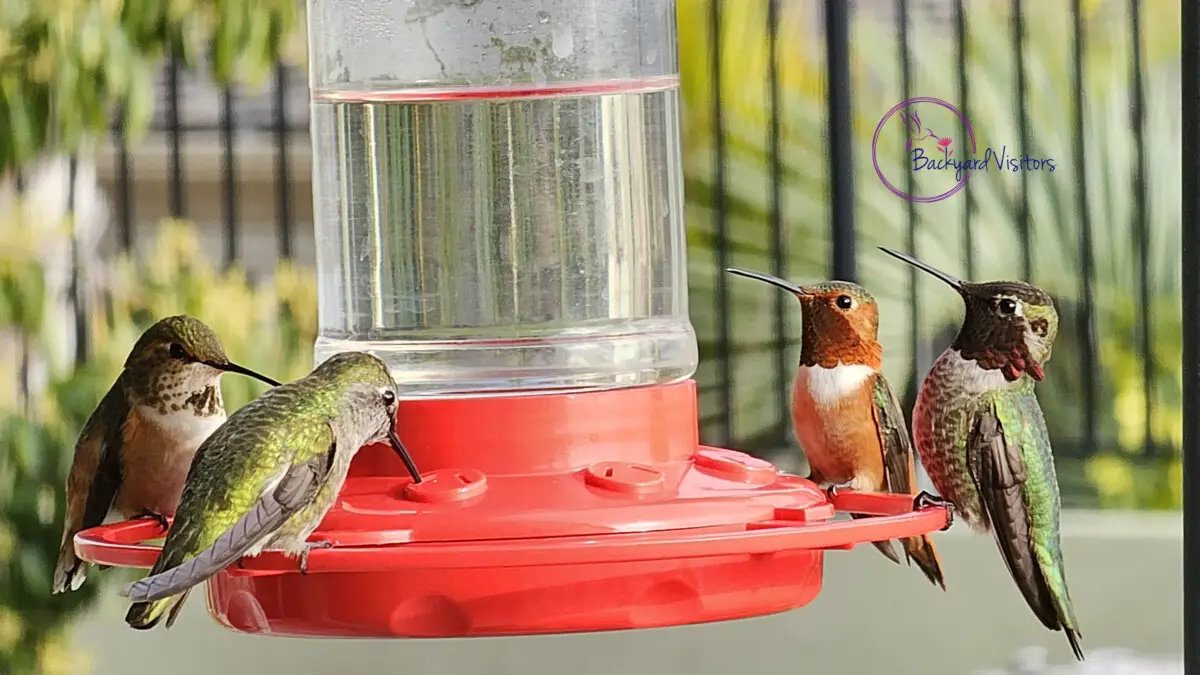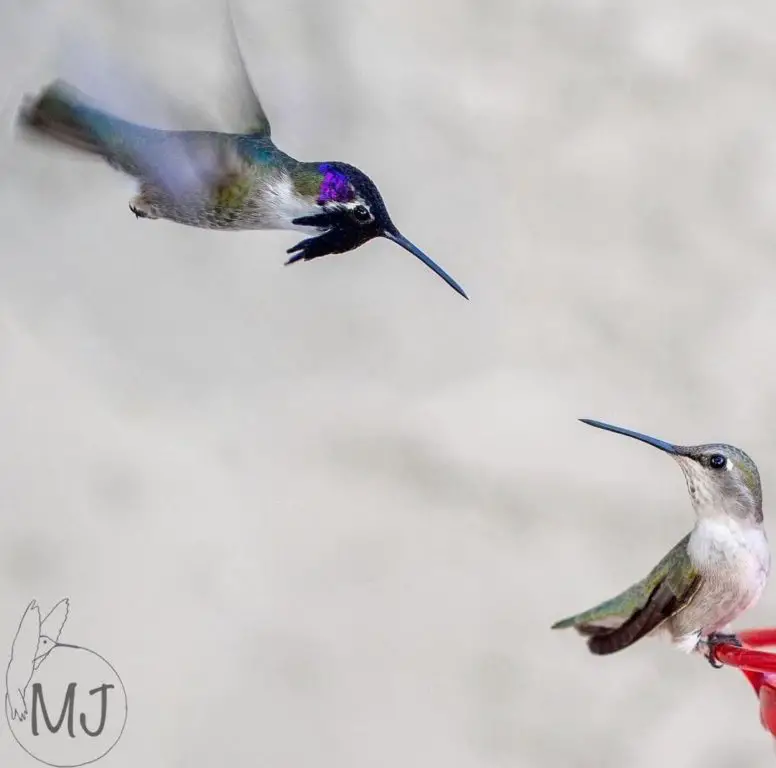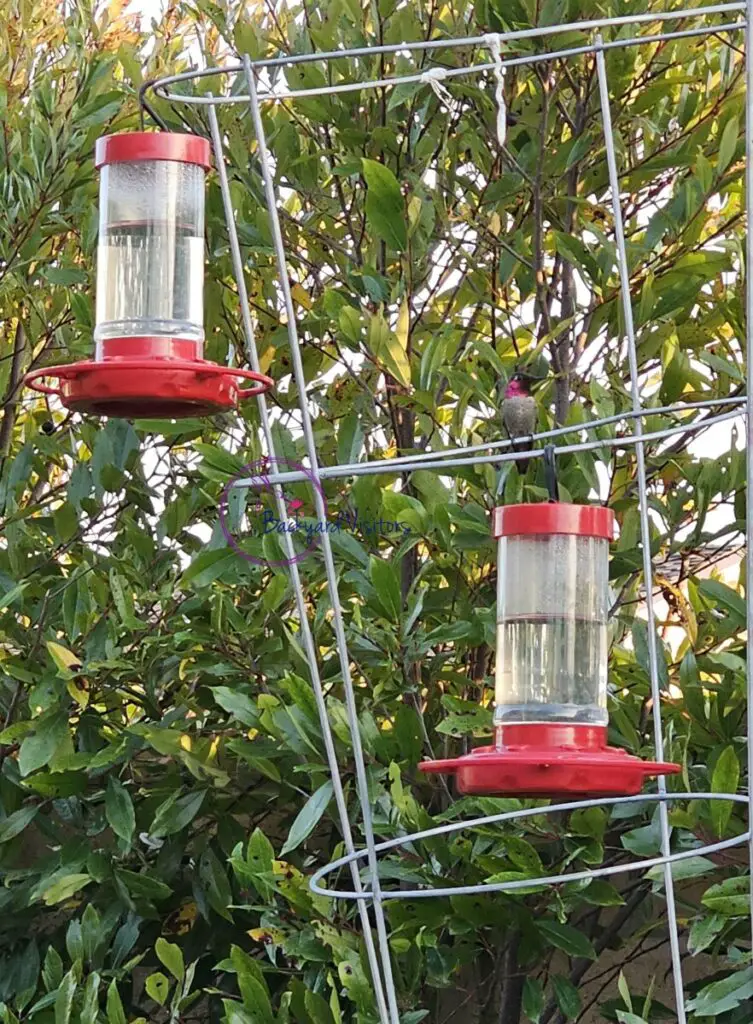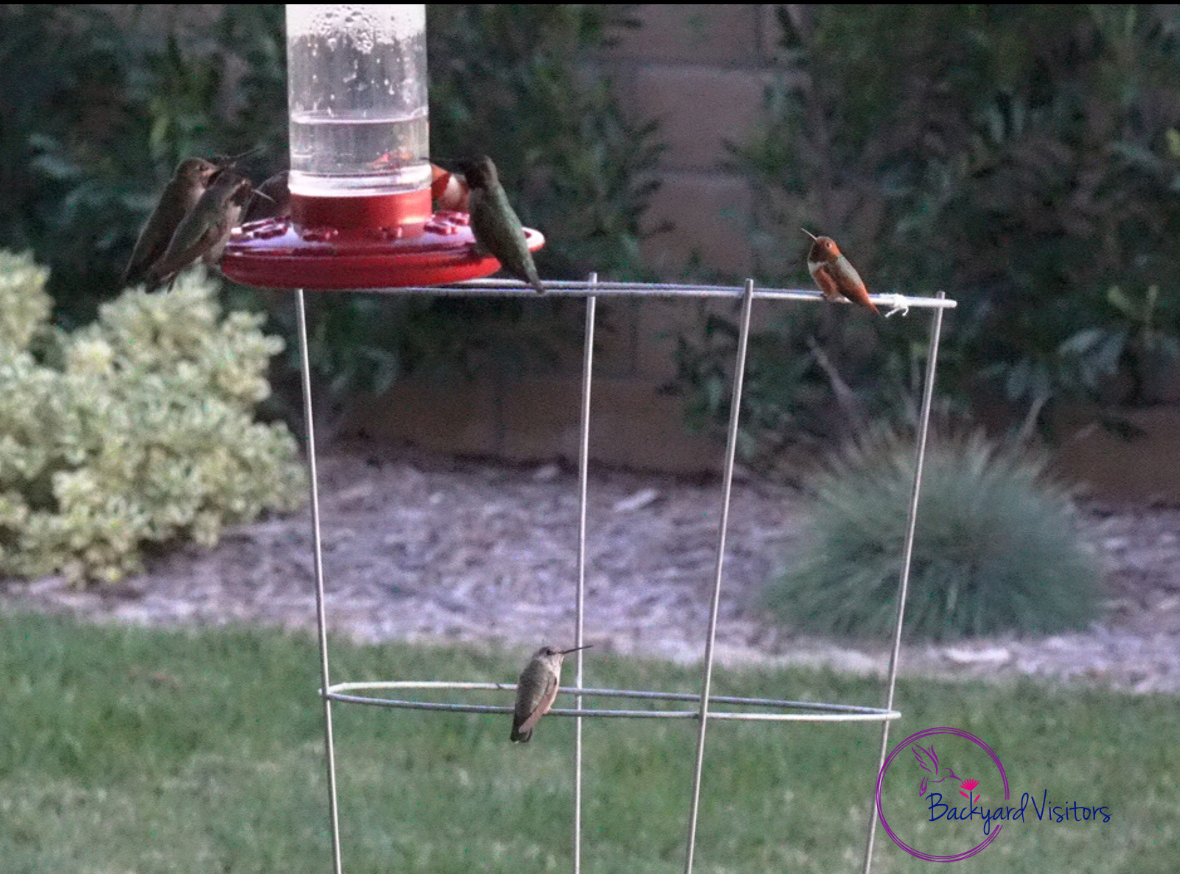This post contains affiliate links.
The fascinating world of hummingbirds captivates our hearts and our gardens. For those of us who relish the presence of these iridescent creatures, a common question arises: how many hummingbirds will share a feeder? This delicate dance of sharing and territory is a spectacle to behold, and understanding it can significantly enhance our bird-watching experiences.
In this article, we delve into the dynamics of hummingbird feeders and territory, providing insights for enthusiasts looking to create a harmonious haven for their beloved visitors.
Understanding Hummingbird Feeder Territory: How Many Birds Will Share?
When it comes to the enchanting world of hummingbirds, many enthusiasts are intrigued by the dynamics that unfold at a hummingbird feeder. Hummingbirds are territorial creatures, and the number that will share a feeder that is set up depends on several factors. It is not just about how many feeders there are, but rather the personality and species of the hummingbird that is crucial in determining the pecking order at the feeders.
In the nectar-driven society of hummingbirds, a feeder is more than just a food source; it is a battleground for supremacy and sustenance. A single dominant bird can claim a feeder, chasing away others to protect its valuable nectar supply.
See my article: Why Hummingbirds Chase Each Other: Is it Friend or Foe?
Yet, as any observer can attest, there are moments when multiple hummingbirds will hover and dine simultaneously, darting in and out with astonishing agility. This intermittent sharing seems to defy the fiercely territorial reputation of these birds.
In my experience, I see many hummingbirds share a feeder during migration and inclement weather. However, the most impressive gathering of hummingbirds is when a new batch of juveniles are gathered around the feeder cooperating, excited to see other like minded birds sharing the feeder that their mothers have taught them as an oasis of nectar.
How many hummingbirds will peaceably sip from the same feeder? In a setting with ample resources and multiple feeders, hummingbird enthusiasts may witness a community where seemingly many hummingbirds coexist.
By placing several hummingbird feeders out of sight of each other, you can encourage a fairer distribution of birds and reduce aerial skirmishes. Indeed, a well-arranged collection of feeders is less likely to become the sole domination of a single bird.

Seasonal changes also play a significant role in feeder sharing. During migration periods, one might see a surge in numbers, with many hummingbirds stopping to refuel. During these times, the feeder’s locale resembles a busy airport, with birds constantly arriving and departing.
Conversely, outside of migration, you may find that fewer birds will visit, and those that do might display more territorial behavior. It is a fascinating ebb and flow, governed by instinct and survival.
Read my article: How Do Hummingbirds Know You Have a Feeder?
For those who delight in witnessing the breathtaking spectacle of hummingbirds in flight, the drama at a feeder can be captivating. Trying to predict exactly how many will share is not just a numbers game—it is a question laced with the intricacies of avian sociology.
Whether your feeder is home to a solitary diner or a fluttering flock, rest assured, each hummingbird is making the most of your hospitable offering. With patience and careful observation, you will gain insights into just how many hummingbirds will — and won’t — share the precious nectar at your feeder.
Feeder Dynamics: Why Is a Hummingbird Feeder Rarely Shared?
The balletic display of hummingbirds as they dart and hover around a hummingbird feeder is a complex dance of fiercely defended territories and energy conservation. Providing multiple hummingbird feeders in our gardens and sighting several hummingbirds sharing a single feeder is uncommon, and understanding this behavior requires insight into their intrinsic nature.
At the heart of this dynamic is the hummingbird’s territorial instinct. A hummingbird is quite territorial, a trait that serves a practical purpose. The energy demands of their rapid wingbeats are immense, and thus, a hummingbird must ensure it has sufficient access to nectar.
A feeder is, in the eyes of a hummingbird, a critical resource – often perceived as an extension of its natural flowering territory. Therefore, a hummingbird will often defend a feeder with the same vigor it would apply to a patch of flowering plants.

Photo by: hummingbirdsbysuprise
When it comes to understanding how many hummingbirds might share a feeder, it is essential to consider that each bird has a unique tolerance level for closeness to its kind. Some hummingbirds may tolerate occasional visitors to “their” feeder, while others may aggressively chase away any intruders.
The perception of adequate resources plays a role as well; if a hummingbird feels the feeder has an endless supply of nectar, it might be “less” aggressive, permitting others to partake intermittently. However, this behavior is not typical and the default is often solitary feeding.
Adding more feeders is a strategy many enthusiasts employ to encourage sharing among hummingbirds. While a single feeder is easily monopolized by one dominant bird, multiple feeders complicate a hummingbird’s ability to claim exclusive rights over the resources. Nevertheless, spacing of the feeders is crucial, as hummingbirds have a keen perception of their surroundings, and feeders placed too close together are often regarded as a singular territory.
Feeder sharing also reflects the seasonality and migratory patterns of hummingbirds. During peak migration periods, there is a noticeable uptick in the number of hummingbirds visiting and briefly sharing feeders. This transient increase in population shifts the feeder dynamics, as the continuous influx of new birds can overwhelm the territorial defenses of resident hummingbirds.
In conclusion, the question of how many hummingbirds will share a hummingbird feeder is interwoven with the nuances of the birds’ inherent territorial behavior. Feeders simply become an extension of the natural territories that hummingbirds defend with such passion.
Although the addition of more feeders encourages sharing to some extent, it is important to understand that these creatures are innately programmed to claim and defend what sustains them—a fact that adds to the intricate beauty and fascination that is the world of hummingbirds.
Insights into Hummingbird Behavior: The Quest to Feed Hummingbirds
As enthusiasts fervently aiming to feed hummingbirds, understanding the nuanced avian dynamics surrounding our feeders offers us further delight and complexity in our backyard birding adventures.
Each species of hummingbird brands distinct behavioral patterns, yet a thread of territoriality is common amongst these iridescent birds. Those seeking to witness a flurry of activity might ponder over how much a single feeder can accommodate and whether multiple hummingbirds can coexist in harmony whilst sharing this coveted resource.
It is a spectacle indeed to watch hummingbirds feed, darting and weaving with aerial finesse, but the cold hard truth is that hummingbirds are fiercely competitive when it comes to their feeding territories.
Read my article: Managing Bully Birds at Feeders
Intuitively, one might assume that setting up a single feeder would invite an inclusive hub for all nearby hummingbirds. Nonetheless, the reality is that often, particularly with males during the breeding season, an established feeder becomes the realm of one dominant individual. This bird will vehemently stake claim over the station, ensuring it will feed without intrusion.
The notion of sharing seems foreign at times, as these vibrant birds exhibit aggressive behaviors to protect their nectar source from other would-be sippers. This possessiveness begs the question central to our pursuits – how many hummingbirds will share a feeder?
Scientific observations and backyard testimonials suggest that feeder dynamics are complex, with variables such as the time of year, feeder placement, and the abundance of natural food sources playing pivotal roles.
During peak feeding times, such as migration or early morning hours, one might observe a modest relaxation in territorial defense, allowing a few hummingbirds to feed simultaneously. Yet, it is not uncommon for skirmishes to erupt as each bird jockeys for a chance to refuel.

To the dedicated bird lover aiming to maximize their feeder’s potential, employing multiple feeders circumvent the territorial blockade. Feeders that are strategically spread out to dilute the dominion of a single hummer will give others the opportunity to sip in peace.
Furthermore, creating a habitat rich with natural food sources and shelter adds layers to your garden that only enhance the likelihood that numerous birds can feed alongside each other. Through trial and error, you will find the balance between the number of feeders, their placement, and the habits of your local hummingbirds.
In the grand scheme, it is clear we are merely visitors in the captivating world of these tiny aerialists. Whether we are seasoned veterans or new enthusiasts, the quest to properly feed hummingbirds and observe their intricate social interactions remains an ongoing and exhilarating challenge.
Let’s continue to meticulously curate our gardens with the hope that one day, perhaps, we will witness a harmonious gathering around our nectar-rich oases, where multiple birds flourish and the sight of more than one hummingbird at a feeder is not a fleeting rarity but a common joy.
Exploring the Reasons Many Hummingbirds Don’t Share Feeders
Hanging a hummingbird feeder in your garden is similar to rolling out a welcome mat for these birds. However, if you have ever observed a feeder throughout the day, you will notice that the idea of many hummingbirds amiably sharing a single feeder is more of wishful thinking than a common reality.
Why don’t many hummingbirds share feeders? The answer lies in their inherently territorial nature, as each bird is programmed to fiercely protect its food source. This tendency ensures their survival and leads to aerial acrobatics and skirmishes that are captivating to watch.
It is essential to recognize that a hummingbird feeder is not just a source of nectar. It represents a prime feeding ground that birds, particularly males during mating season, are inclined to claim as their own.
The presence of multiple feeders to some extent, alleviate this exclusivity, allowing a few hummingbirds to partake simultaneously, but even then, a dominant bird may attempt to oversee all available feeders.
Read my article: Managing Bully Birds at Feeders
At the heart of this behavior is the hummingbird’s intense energetic needs. To sustain its rapid wingbeat and general vigor, a hummingbird is dependent on regular high-sugar fuel. Ensuring a steady nectar supply by defending a feeder is important. When too many birds vie for a single feeder, the competition results in less frequent feeding opportunities for some, as the more aggressive birds secure their dominance over the prime food source.
Despite their size, hummingbirds are not creatures of passive communion. The very notion of sharing seems to contradict their solitary feeding habits. When a hummingbird feeder is filled with sweet nectar, it does not invite a gathering; rather, it sets the stage for a feisty display of aerial prowess where only the most tenacious bird maintains access.

In settings where several feeders are presented, hummingbirds may establish a loose “time-share” system, where a brief window for feeding is assertively patrolled by the dominant individual before another opportunistically takes a turn.
Even though feeder sharing is not a common sight to behold, hummingbirds do occasionally tolerate each other’s presence. Migratory routes, breeding patterns, and even the sheer number of birds in an area influence the degree of sharing that occurs at the feeders.
In essence, understanding why a hummingbird feeder is not widely shared among birds requires an appreciation of the hummingbird’s behavioral ecology. Their seemingly selfish nature at the feeder is, in fact, a vital adaptive strategy for survival. By closely managing the number of feeders and their positions, enthusiasts witness a constantly shifting balance of power and cooperation among these dynamic birds, ensuring that each hummingbird feeder is a buzzing hub of avian activity.
How to Feed Multiple Territorial Hummingbirds: Strategies for Feeders
Feeding multiple territorial hummingbirds is quite the spectacle for bird enthusiasts. Ensuring that multiple feeders are available is crucial for peace and harmony among these vibrant birds.
Hummingbirds are known for their territorial instincts, which means a single hummingbird feeder rarely accommodates more than one bird at a time. However, with at least two feeders strategically placed, you create opportunities for more hummingbirds to feed without direct conflict. The key is to position the multiple hummingbird feeders out of sight from each other so that one dominant bird cannot guard all the feeding spots at once.
To maintain an environment where many hummingbird feeders coexist, vigilant observation is required. Watching where birds defend their territory provide insights into where additional feeders might be most beneficial.
Though hummingbirds are solitary when it comes to feeding, setting up many feeders ensures that even the shyest of birds has a chance to dine and partake. It is not just about quantity, but also feeder placement, style, and maintenance.
The nectar should be of the highest quality and the feeders clean, making multiple feeders a more attractive option for the birds.
Read my article: Forget Commercial Hummingbird Food, Try Making Homemade Nectar
If you are hoping to see a flutter of activity at your feeders, try placing them in various locations around your yard to alleviate aggressive behavior. This allows more hummingbirds to feed simultaneously, as the dominant bird cannot monopolize all the feeders if they are out of visual range.
The beauty of having multiple hummingbird feeders is not only in the potential to feed many hummingbirds but also in the spread of vibrant colors and animated interactions throughout your garden.
Remember that the placement of feeders significantly affects the number of hummingbirds that will share the nectar. For instance, if two feeders are in close proximity, more dominant birds might still engage in aerial chases to fend off competition. But when feeders are scattered, it gives less dominant hummingbirds a chance to sneak in for a quick sip.
Keep in mind that not all yards will accommodate many feeders due to space constraints, but even in smaller areas, strategic placements make a world of difference.
Ultimately, feeding hummingbirds is a combination of patience, strategy, and a love for these incredible birds. With thoughtfully placed feeders and a respectful distance between them, you will enjoy the aerial acrobatics of many hummingbirds. Your yard will become a hub of colorful, humming activity, a testament to your dedication to feeding these magnificent creatures.
The Art of Feeding Many Hummingbirds: Tips for a Peaceful Feeder
Hummingbird enthusiasts often ponder how to successfully feed hummingbirds in a harmonious manner, as these avian jewels are known for their territorial tendencies. A frequent question that arises is how many hummingbirds will share a feeder without causing a flurry of feathers in fierce aerial combat. While it is challenging to predict an exact number, and the dynamics at the feeder changes daily, certain practices increase the chance of observing multiple birds dining in relative peace.
Creating an inviting space for many hummingbirds starts with understanding the balance between feeding opportunities and the natural territorial instincts of these birds. When placing hummingbird feeders around your garden, consider spacing them sufficiently apart. This allows the birds to claim their own feeding area without feeling encroached upon by others.
Employing multiple feeders has proven effective, as it disperses the birds and dilutes the concentration of activity around a single source of nectar.
Selecting the right location is also key in your quest to feed hummingbirds peacefully. A feeder set against a backdrop of foliage offers not only a sense of security but also a strategic vantage point from which birds survey their feeding grounds.
In my backyard I have hummingbird feeders placed in front of a backdrop of vertical bushes that are lined all in a row. They feel protected and sheltered from the foliage of the bushes when they feed making it an effective dining experience.
Additionally, by placing feeders at varying heights, you provide natural barriers that can help reduce the visibility of one feeder to another, thereby lessening aggressive encounters. When there are many feeders available, the likelihood that many hummingbirds feed simultaneously without conflict increases significantly.
Read my article: How High Should a Hummingbird Feeder Be
The design of the hummingbird feeder itself plays a role in how peacefully hummingbirds coexist at a feeding station. A feeder that has several feeding ports spaced widely apart allows multiple birds to feed at once, fostering a more peaceful atmosphere.
Moreover, you will feed more effectively if you select feeders with built-in ant moats and bee guards to prevent insects from monopolizing the nectar supply and frustrating your feathered guests.
Ensure a steady influx of birds by maintaining a consistent nectar supply in your hummingbird feeders. Regular cleaning and nectar replacement not only keep the feeders safe and healthy for the birds but also reinforce the feeders as reliable food sources.
Over time, as the hummingbirds come to recognize the constancy of your offerings, you may notice that a higher number of individuals will take turns at the feeder, displaying a form of temporal sharing.
Enticing multiple hummingbirds to a feeder is an attainable goal with patient observation and strategic feeder management. By embracing these tips, you will feed a delightful array of hummingbirds and enjoy the bustling activity they bring to your garden. The sight of many hummingbirds engaging in a delicate ballet around your feeder becomes a testament to the peaceful coexistence that you have fostered, providing many enchanting moments for you to cherish.
Maximizing Your Hummingbird Feeders: Attracting Multiple Birds
If you are a hummingbird enthusiast, you will want to set up a colorful environment in your yard where hummingbirds dance around several feeders. The satisfaction of observing a variety of hummingbirds consuming nectar at the same time is exceptional.
To achieve this, understanding the dynamics of hummingbird feeder sharing and ensuring many hummingbird feeders are available is paramount. While a lone hummingbird feeder becomes the hotspot for territorial disputes, strategically placing several feeders within your space significantly increases the chance of attracting multiple birds.

How many hummingbirds will share a single feeder is often dependent on the personalities of the birds themselves and the layout of your feeder setup. To cater to these dynamic flyers, dispersing feeders out of sight from each other can discourage the feisty birds from claiming all the feeders as their personal dining spots. By doing so, you are essentially offering multiple dining areas for these birds, each potentially hosting a charming display of hummingbird activity.
Yet, it is not just about scattering many hummingbird feeders across your domain. The aesthetic and functional design of each feeder plays a crucial role in attracting these birds. A feeder that mimics the blooms they naturally favor might entice them more than a mundane vessel.
Moreover, meticulous cleanliness is vital; poorly maintained feeders lead to the spread of disease, which is why vigilance in feeder hygiene is a must. Through diligent care and consideration, you can ensure your feeders are poised to welcome multiple birds throughout the hummingbirds’ feeding sessions.
Read my article: Hummingbird Diseases: From Pathogens to Prevention
When considering how many hummingbird feeders to provide, it is advisable to create a habitat that encompasses a variety of natural food sources, such as flowering plants and insect attractants. The presence of natural forage will complement your feeder offerings and can aid in attracting multiple birds, who may relish in the diversity of the provisions you’ve set out for them.
Read my article: Increase Backyard Hummingbird Activity in 7 Days or Less
As you observe your feeders, you will find that some days they may host a fluttering congress of hummingbirds, while on other days the feeders may welcome a more modest assemblage, outlining the unpredictable nature of these aerial acrobats.
Patience is, therefore, an integral part of the hummingbird enthusiast’s repertoire. It is a joyous occasion when multiple hummingbirds share a single feeder, an event that is often fleeting yet utterly enchanting.
I have witnessed on multiple occasions happy hummingbirds sharing a feeder. I sometimes feel bad when there are not enough ports to sustain the amount of hungry beaks, however if I have a feeder with flower ports, some hummingbirds will take turns and share the same port. The flower ports have larger circular holes that allow hummingbirds to take turns to feed if they so choose.
This avian ballet is more prevalent when multiple feeders available are part of your garden’s allure, each promising a sip of sweet nectar in a peaceful corner. Such planning affords you the luxury of witnessing the varying dynamics between birds as they navigate the sky, perch momentarily on a feeder, then zip away, perhaps to explore another one of the many hummingbird feeders in your haven.
Ultimately, the query of how many hummingbirds will share a feeder is not one with a concrete answer; rather, it is a heartwarming challenge for enthusiasts. With careful planning, ensuring feeder accessibility, and fostering a habitat rich in natural food sources, you can establish a communal dining experience that attracts an array of hummingbirds, each vying for a sip from your generous offerings.
Check out my other posts on Hummingbird Questions
Frequently Asked Questions
Q: How many hummingbirds will share a feeder?
A: The number of hummingbirds that will share a feeder varies based on factors such as the feeder’s location, the amount and concentration of nectar, territorial behavior of individual birds, and the number of feeders available. Some may tolerate occasional visitors, while others aggressively chase away competitors. Spreading multiple feeders out of sight from one another can encourage a higher number of hummingbirds to feed simultaneously.
Q: What factors determine the pecking order at a hummingbird feeder?
A: The pecking order at a hummingbird feeder is influenced by the personality and species of the hummingbirds, as well as the perceived value of the feeder’s nectar supply. Dominant birds often claim feeders and chase away others, although this can vary, with some allowing intermittent sharing.
Q: Can placing multiple hummingbird feeders reduce aggression among birds?
A: Placing several hummingbird feeders out of sight from each other can help reduce aggression and territorial behavior, encouraging fairer distribution and allowing more hummingbirds to use the feeders without interference from a dominant bird.
Q: Do hummingbirds share feeders more frequently during certain times?
A: During migration periods and peak feeding times like early mornings, hummingbirds may share feeders more due to increased numbers and the urgency to refuel for their journey or daily activities. Territorial defense may be less strict during these times, allowing for some sharing.
Q: How important is the placement of hummingbird feeders in reducing territorial behavior?
A: The placement of hummingbird feeders is crucial in reducing territorial behavior. Feeders should be placed sufficiently apart and out of sight from each other to prevent a single bird from being able to guard multiple food sources. This encourages multiple hummingbirds to feed without direct conflict.
Happy Hummingbird Watching!
Backyard Visitors is a participant in the Amazon Services LLC Associates Program, an affiliate advertising program designed to provide a means for sites to earn advertising fees by advertising and linking to Amazon.com. We also participate in other affiliate programs which compensate us for referring traffic.

